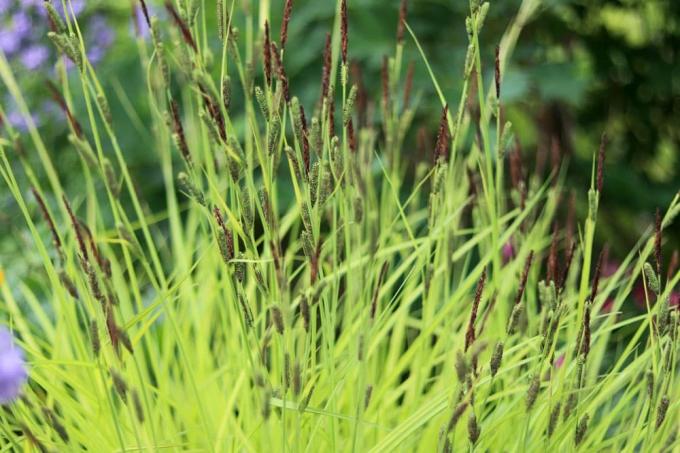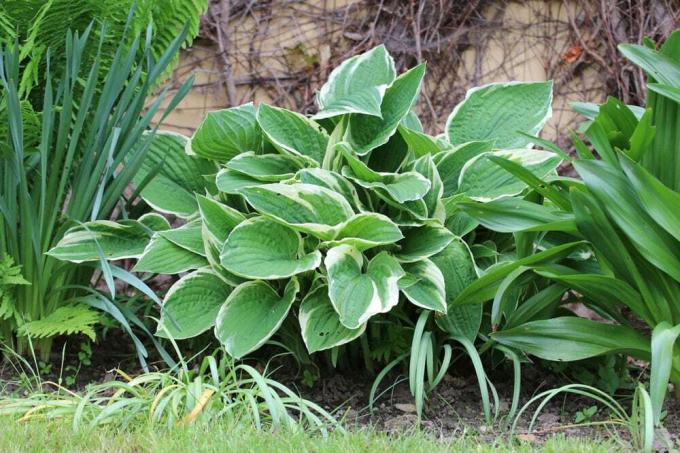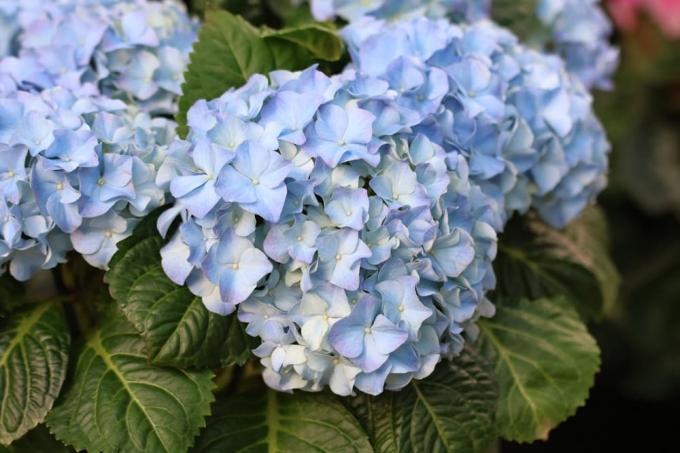

Table of contents
- Culture in the bucket
- ferns
- Little goatee
- Evergreen honeysuckle
- sedges
- hostas and hosta hybrids
- bamboo
- herb of immortality
Hardy pot plants are a year-round enrichment and decoration for the front door, the balcony and the terrace or otherwise unplanted corners in the garden. They are even more conspicuous and versatile if they can also thrive in the shade without any problems. Many assume that there is a limited selection here - but in fact there are numerous hardy plants for shady areas in question.
Culture in the bucket
No matter which potted plant you choose, there are a few basic rules to follow when cultivating in a planter. These are:
- Choose a planter that is as small as possible and as large as necessary
- Ensure water drainage
- Keep large tubs mobile with a plant trolley
If there is too much soil volume available to the plant, a lot of energy is initially invested in root growth. As a result, the above-ground part of the plant grows less. On the other hand, smaller tubs require more frequent repotting or at least faster soil change.
Excess water can collect in a planter or saucer and lead to waterlogging. The risk of damage resulting from this is significantly higher than with plants that are planted outdoors. Therefore, the drainage of the water must be ensured in any case. It is a good idea - especially with very large tubs and plants - to do without cover pots and saucers altogether.
In all-over shady locations, plants generally do not stretch as strongly and quickly towards the light, but it is still possible. The plants then grow one-sided and can become unsightly or lose stability. With very large and heavy tubs, plant rollers or furniture rollers can solve the problem. The planters can be moved regularly on them to promote even growth.
ferns

Ferns may seem like an unusual choice to many – especially when it comes to hardiness. However, there are some representatives that can easily cope with both frost and a shady location. These include, among others:
- elephant trunk fern
- stone feather
- Wood Lady Fern
The elephant trunk fern grows to a height of about 60 centimeters and has rich, dark green leaves that retain their color even in winter in suitable locations in shady or partially shaded areas. However, it is only hardy down to temperatures of around -12 to -17°C. It must therefore be protected in very cold regions or in severe frost.
Unlike the Steinfeder. This fern species can withstand temperatures down to -40°C, but as a semi-evergreen plant it can lose some of its leaves.
So it doesn't need any protection. In addition, the Steinfeder is also moderately drought tolerant, but prefers moist substrate. Should it be even more robust, the forest lady fern could be suitable. It likes half shade to shade, but also tolerates sun. However, it then grows rather sparsely. In terms of winter hardiness, it corresponds to the Steinfeder and therefore requires no protection.
Tip:
Other types of ferns, such as moss fern or the downy filigree fern, are also suitable for planting in pots in shady areas, looking around and also combining different ferns in the vegetation is worthwhile itself.
Little goatee
The little goat's beard is not only ideal for partially shaded locations, it is also hardy down to -30°C. Since these temperatures are rarely reached in our latitudes, it does not need winter protection. At around 30 centimetres, it remains low and compact, tolerates pruning and is very easy to care for. In addition, the little goat's beard flowers between June and July, but then develops decorative infructescence. These, in turn, can persist well into winter.
Evergreen honeysuckle
Full midday sun or deep shade - the evergreen honeysuckle tolerates both and everything in between. This makes it the ideal plant for the entrance area or other locations where there are very different lighting conditions.
However, the peculiarity of the evergreen honeysuckle lies not only in this great tolerance. It is also easy to care for and a fairly fast-growing climber. If it receives a climbing aid, it can be brought into the desired shape and thus, for example, entwine the front door or green a pergola.
sedges

Sedges are ornamental grasses that are extremely robust and available in different colors and sizes. Planted alone in the tub, they look simple. As a border for a figure or in combination with other plants, they become a decorative and easy-care basis. A combination of different colored sedges can also be very appealing. In addition, the hardy plants do not need large tubs for partially shaded locations. They are also suitable for narrow entrance areas and attract attention with their decorative spikes.
Available are among others:
- Gold-rimmed sedge or brocade sedge
- Carpet Japan Sedge
- New Zealand sedge
- flea sedge
- Crooked Sedge
Tip:
The dried spikes that have been cut off are also very decorative as dried flowers in the vase.
hostas and hosta hybrids

Almost round, slightly curved leaves and numerous plays of colors in green, white and gold make the hostas or hosta hybrids robust eye-catchers. In midsummer, they also produce enchanting flowers. They are suitable for locations in semi-shade to shade and do not tolerate the sun very well. This makes them ideal for very dark areas.
In winter, they rarely need special protection in temperate climates. They endure temperatures from -23 to -28°C. Incidentally, the hostas, which are up to 45 centimeters high, have a particularly decorative effect when different colored shapes are combined with one another. Available are among others:
- White-bordered Funkie
- Redstick Funkie
- Gold Rim Funkie
- Wavy Gold Funkie
- Round-leaved hosta
bamboo

As with the ferns mentioned at the beginning, many hobby gardeners would not think of bamboo if they wanted to green a shady corner even in winter. This is not only ideal, but also available in an unimagined number of variations. Different leaf shapes and heights allow numerous bamboo combinations. You only have to pay attention to the winter hardiness and any necessary protection against frost damage. Some bamboo species tolerate temperatures from -12 to -17°C, while others are hardy to around -20°C.
Recommended bamboo species include:
- Ruscus bamboo with small leaves and dense growth, grows between 60 and 120 centimeters high
- Dwarf bamboo with narrow leaves and a height of about 40 centimeters
- Garden bamboo with filigree leaves and a height of up to 400 centimeters, ideal for very large tubs
Tip:
Some bamboo species form very strong runners, which can quickly make the bucket too small. It is therefore advisable to choose species that do not sprout or to divide the bamboo every two years so that it still fits in the planter.
herb of immortality
The herb of immortality is an unusual and still relatively unknown plant from Asia. As a medicinal herb, however, it is used very frequently, especially in its country of origin, China. The special thing about the herb of immortality: It can be used as a hanging plant, ground cover or climbing plant.

This allows a very versatile use in the planting of entrance areas. The shoots are 80 to 200 centimeters long, can hang from a traffic light or a high bucket, but can also be attached to climbing aids and thus pulled up. The medicinal plant is hardy down to a temperature of about -18°C. However, in the first year, in very harsh winters or with young plants, protection should be provided to avoid frost damage.
A frost-free winter indoors can also be recommended if the five-lobed leaves are to be harvested fresh. Because as long as the herb of immortality does not have to endure sub-zero temperatures, it continues to grow and thus offers young shoots again and again, even in winter.
 garden editorial
garden editorial I write about everything that interests me in my garden.
Learn more about potted plants

Spider Flower, Cleome hassleriana: Care Instructions
Spider flowers get their name from their spider-like appearance. Many hobby gardeners shy away from cultivating the beautiful exotic species. When it comes to maintenance, there are just a few things to keep in mind.

How do I care for a gentian tree? Lycianthes rantonnetii
A gentian tree can be a decorative enrichment both on the balcony and in the garden. For the culture, however, some criteria must be observed. This includes, among other things, the high nutrient content that is required for flowering.

Overwinter pampas grass | 16 tips for winterizing
Pampas grass is a popular ornamental plant in the garden or in tubs, which can be attractively integrated into a wide variety of garden ideas thanks to its decorative fronds. They are considered hardy, but need suitable winter protection in Central Europe due to possible moisture damage.

Leadwort, plumbago: care from A to Z
Leadwort (Plumbago) hides one of the most attractive potted plants of all. The magnificent shrub impresses above all with its blue flowers, which it produces from May to autumn, transforming terraces and balconies into a luminous oasis.

Hydrangeas, rhododendrons and hibiscus smoke | dangers of drugs
Anyone who has cultivated hydrangeas, rhododendrons or hibiscus in the front yard may be surprised that the beautiful flowers were cut off by strangers. Because especially among young people, there is a rumor that these flowers can be smoked and have the effect of marijuana. But this is dangerous information.

Peasant hydrangea, Hydrangea macrophylla - care and pruning
With its attractive, ball-shaped umbels of flowers in white, pink, purple, red or blue, the hydrangea is one of the most decorative garden plants. Here's what you need to know about the farmer's hydrangea so that it blooms and thrives lushly in your garden.


